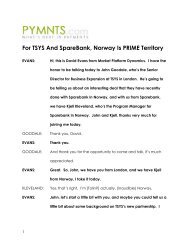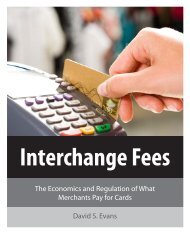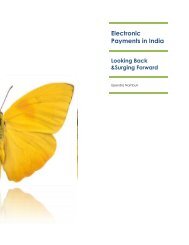Lydian Payments Journal - PYMNTS.com
Lydian Payments Journal - PYMNTS.com
Lydian Payments Journal - PYMNTS.com
Create successful ePaper yourself
Turn your PDF publications into a flip-book with our unique Google optimized e-Paper software.
Portugal 24.3<br />
Finland 8.5<br />
Eurozone 12.4<br />
Source: European Commission (2004)<br />
With Luxembourg as an exception, the countries all had a market share of 25% or less of foreign banks or<br />
other credit institutions. For the Euro Zone as a whole, foreign banks on average had a market share of less<br />
than 15%. This low average mainly reflects the very low market shares of foreign banks in the largest Euro<br />
Zone countries (Germany, France, Italy, and Spain) which were typically less than 10%. This lack of<br />
integration of the banking sector contrasted greatly with other sectors of the economy. 4<br />
Although EU regulation has be<strong>com</strong>e evermore effective, the presence of foreign banks has not grown<br />
remarkably in most (old) EU countries. Also, many EU countries already have a high concentration of banks<br />
(for example, Sweden, Belgium, and Portugal), with apparent additional growth from 2002 until recently.<br />
Furthermore, apart from a small but growing number of notable exceptions, M&A activity largely takes<br />
place within national boundaries. An early example to the contrary was the Swedish/Finnish Merita<br />
Nordbanken merger of 1998.<br />
Euro Payment Infrastructure Development<br />
Another item not covered by the introduction of the Euro was the EU payment infrastructure. Parallel to<br />
the introduction of the Euro, regulation was implemented to liberalize, deregulate, and harmonize financial<br />
markets and institutions with the aim of cutting the costs of cross‐border payments. In the past, cash flows<br />
between European countries were obstructed by high transfer payments by banks. 5 With intra‐EU cash<br />
transactions, often both the payer and the receiver were charged. Maybe almost as bad, there were<br />
administrative burdens as well.<br />
In a discussion paper 6 published in 1990, the then European Commission made it clear that establishing an<br />
equitable payment infrastructure within Europe was critical to the success of its overall goal: “The prospect<br />
of economic and monetary union which will lead to a further increase in intra<strong>com</strong>munity trade makes it all<br />
the more urgent to ensure that Europe is equipped with structures which provide as cheap, as rapid and as<br />
reliable a payments service between different Member States of the Community as already exists within them.”<br />
4 P. De Grauwe. Economics of Monetary Union. (Oxford: Oxford University Press, 2005).<br />
5 H. Von Eije. and W. Westerman, “Multinational Cash Management and Conglomerate Discounts in the Euro Zone,”<br />
International Business Review. 11(4):. 453‐464 (2002).<br />
6 European Commission, Making <strong>Payments</strong> in the Internal Market, COM (90) 447:1, 26 September 1990.<br />
© 2009. Copying, reprinting, or distributing this article is forbidden by anyone other than the publisher or author. 7








